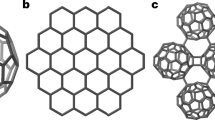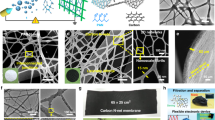Abstract
Carbon nanostructures that feature two-dimensional extended nanosheets are important components for technological applications such as high-performance composites, lithium-ion storage, photovoltaics and nanoelectronics. Chemical functionalization would render such structures better processable and more suited for tailored applications, but typically this is precluded by the high temperatures needed to prepare the nanosheets. Here, we report direct access to functional carbon nanosheets of uniform thickness at room temperature. We used amphiphiles that contain hexayne segments as metastable carbon precursors and self-assembled these into ordered monolayers at the air/water interface. Subsequent carbonization by ultraviolet irradiation in ambient conditions resulted in the quantitative carbonization of the hexayne sublayer. Carbon nanosheets prepared in this way retained their surface functionalization and featured an sp2-rich amorphous carbon structure comparable to that usually obtained on annealing above 800 °C. Moreover, they exhibited a molecularly defined thickness of 1.9 nm, were mechanically self-supporting over several micrometres and had macroscopic lateral dimensions on the order of centimetres.
This is a preview of subscription content, access via your institution
Access options
Subscribe to this journal
Receive 12 print issues and online access
$259.00 per year
only $21.58 per issue
Buy this article
- Purchase on Springer Link
- Instant access to full article PDF
Prices may be subject to local taxes which are calculated during checkout





Similar content being viewed by others
References
Novoselov, K. S. et al. Electric field effect in atomically thin carbon films. Science 306, 666–669 (2004).
Geim, A. K. & Novoselov, K. S. The rise of graphene. Nature Mater. 6, 183–191 (2007).
Angelova, P. et al. A universal scheme to convert aromatic molecular monolayers into functional carbon nanomembranes. ACS Nano 7, 6489–6497 (2013).
Matei, D. G. et al. Functional single-layer graphene sheets from aromatic monolayers. Adv. Mater. 25, 4146–4151 (2013).
Guldi, D. M. & Sgobba, V. Carbon nanostructures for solar energy conversion schemes. Chem. Commun. 47, 606–610 (2011).
Burghard, M., Klauk, H. & Kern, K. Carbon-based field-effect transistors for nanoelectronics. Adv. Mater. 21, 2586–2600 (2009).
Rogers, J. A., Lagally, M. G. & Nuzzo, R. G. Synthesis, assembly and applications of semiconductor nanomembranes. Nature 477, 45–53 (2011).
Sekitani, T. & Someya, T. Stretchable, large-area organic electronics. Adv. Mater. 22, 2228–2246 (2010).
Unarunotai, S. et al. Conjugated carbon monolayer membranes: methods for synthesis and integration. Adv. Mater. 22, 1072–1077 (2010).
van der Zande, A. M. et al. Large-scale arrays of single-layer graphene resonators. Nano Lett. 10, 4869–4873 (2010).
Ang, P. K. et al. A bioelectronic platform using a graphene–lipid bilayer interface. ACS Nano 4, 7387–7394 (2010).
Georgakilas, V. et al. Functionalization of graphene: covalent and non-covalent approaches, derivatives and applications. Chem. Rev. 112, 6156–6214 (2012).
Hoheisel, T. N., Schrettl, S., Szilluweit, R. & Frauenrath, H. Nanostructured carbonaceous materials from molecular precursors. Angew. Chem. Int. Ed. 49, 6496–6515 (2010).
Mas-Balleste, R., Gomez-Navarro, C., Gomez-Herrero, J. & Zamora, F. 2D materials: to graphene and beyond. Nanoscale 3, 20–30 (2011).
Yuan, C. Z. et al. Hierarchically structured carbon-based composites: design, synthesis and their application in electrochemical capacitors. Nanoscale 3, 529–545 (2011).
Li, X. et al. Large-area synthesis of high-quality and uniform graphene films on copper foils. Science 324, 1312–1314 (2009).
Sun, Z. et al. Growth of graphene from solid carbon sources. Nature 468, 549–552 (2010).
Liu, H. T. et al. Photochemical reactivity of graphene. J. Am. Chem. Soc. 131, 17099–17101 (2009).
Sinitskii, A. et al. Kinetics of diazonium functionalization of chemically converted graphene nanoribbons. ACS Nano 4, 1949–1954 (2010).
Georgakilas, V. et al. Organic functionalisation of graphenes. Chem. Commun. 46, 1766–1768 (2010).
Wang, X. R., Tabakman, S. M. & Dai, H. J. Atomic layer deposition of metal oxides on pristine and functionalized graphene. J. Am. Chem. Soc. 130, 8152–8153 (2008).
An, X. H. et al. Stable aqueous dispersions of noncovalently functionalized graphene from graphite and their multifunctional high-performance applications. Nano Lett. 10, 4295–4301 (2010).
Zasadzinski, J. A., Viswanathan, R., Madsen, L., Garnaes, J. & Schwartz, D. K. Langmuir–Blodgett films. Science 263, 1726–1733 (1994).
Ulman, A. Formation and structure of self-assembled monolayers. Chem. Rev. 96, 1533–1554 (1996).
Sakamoto, J., van Heijst, J., Lukin, O. & Schluter, A. D. Two-dimensional polymers: just a dream of synthetic chemists? Angew. Chem. Int. Ed. 48, 1030–1069 (2009).
Gros, L., Ringsdorf, H. & Schupp, H. Polymeric antitumor agents on a molecular and on a cellular level? Angew. Chem. Int. Ed. Engl. 20, 305–325 (1981).
Chechik, V., Crooks, R. M. & Stirling, C. J. M. Reactions and reactivity in self-assembled monolayers. Adv. Mater. 12, 1161–1171 (2000).
Scott, J. C., Samuel, J. D. J., Hou, J. H., Rettner, C. T. & Miller, R. D. Monolayer transistor using a highly ordered conjugated polymer as the channel. Nano Lett. 6, 2916–2919 (2006).
Szilluweit, R. et al. Low-temperature preparation of tailored carbon nanostructures in water. Nano Lett. 12, 2573–2578 (2012).
Néabo, J. R., Vigier-Carrière, C., Rondeau-Gagné, S. & Morin, J-F. Room-temperature synthesis of soluble, fluorescent carbon nanoparticles from organogel precursors. Chem. Commun. 48, 10144–10146 (2012).
Ding, L. & Olesik, S. V. Synthesis of polymer nanospheres and carbon nanospheres using the monomer 1,8-dihydroxymethyl-1,3,5,7-octatetrayne. Nano Lett. 4, 2271–2276 (2004).
Luo, L. et al. Room-temperature carbonization of poly(diiododiacetylene) by reaction with Lewis bases. J. Am. Chem. Soc. 133, 19274–19277 (2011).
Levesque, I. et al. Layered graphitic materials from a molecular precursor. Chem. Sci. 5, 831–836 (2014).
Hoheisel, T. N. & Frauenrath, H. A convenient Negishi protocol for the synthesis of glycosylated oligo(ethynylene)s. Org. Lett. 10, 4525–4528 (2008).
Hoheisel, T. N. et al. A multistep single-crystal-to-single-crystal bromodiacetylene dimerization. Nature Chem. 5, 327–334 (2013).
Davies, J. T. & Rideal, E. K. Interfacial Phenomena 2nd edn (Academic Press, 1963).
Mendelsohn, R., Mao, G. & Flach, C. R. Infrared reflection–absorption spectroscopy: principles and applications to lipid–protein interaction in Langmuir films. Biochim. Biophys. Acta Biomembranes 1798, 788–800 (2010).
Kuzmin, V. L. & Mikhailov, A. V. Molecular theory of light reflection and applicability limits of the macroscopic approach. Opt. Spectrosc. (USSR) 51, 383–385 (1981).
Kuzmin, V. L., Romanov, V. P. & Michailov, A. V. Reflection of light at the boundary of liquid systems and structure of the surface layer: a review. Opt. Spectrosc. 73, 1–26 (1992).
Schwieger, C., Chen, B., Tschierske, C., Kressler, J. & Blume, A. Organization of T-shaped facial amphiphiles at the air/water interface studied by infrared reflection absorption spectroscopy. J. Phys. Chem. B 116, 12245–12256 (2012).
Szafert, S. & Gladysz, J. A. Update 1 of: Carbon in one dimension: structural analysis of the higher conjugated polyynes. Chem. Rev. 106, PR1–PR33 (2006).
Chalifoux, W. A. & Tykwinski, R. R. Synthesis of polyynes to model the sp-carbon allotrope carbyne. Nature Chem. 2, 967–971 (2010).
Baughman, R. H. Solid-state synthesis of large polymer single crystals. J. Polym. Sci. Polym. Phys. Ed. 12, 1511–1535 (1974).
Enkelmann, V. Structural aspects of the topochemical polymerization of diacetylenes. Adv. Polym. Sci. 63, 91–136 (1984).
Eda, G. et al. Blue photoluminescence from chemically derived graphene oxide. Adv. Mater. 22, 505–509 (2010).
Kumar, P. V. et al. Scalable enhancement of graphene oxide properties by thermally driven phase transformation. Nature Chem. 6, 151–158 (2014).
Cao, L., Meziani, M. J., Sahu, S. & Sun, Y-P. Photoluminescence properties of graphene versus other carbon nanomaterials. Acc. Chem. Res. 46, 171–180 (2013).
Veca, L. M. et al. Polymer functionalization and solubilization of carbon nanosheets. Chem. Commun. 2565–2567 (2009).
Ferrari, A. C. & Robertson, J. Interpretation of Raman spectra of disordered and amorphous carbon. Phys. Rev. B 61, 14095–14107 (2000).
Ferrari, A. C. & Robertson, J. Resonant Raman spectroscopy of disordered, amorphous, and diamondlike carbon. Phys. Rev. B 64, 075414 (2001).
Casiraghi, C., Ferrari, A. C. & Robertson, J. Raman spectroscopy of hydrogenated amorphous carbons. Phys. Rev. B 72, 085401 (2005).
Falcao, E. H. L. & Wudl, F. Carbon allotropes: beyond graphite and diamond. J. Chem. Technol. Biotechnol. 82, 524–531 (2007).
Börrnert, F. et al. Amorphous carbon under 80 kV electron irradiation: a means to make or break graphene. Adv. Mater. 24, 5630–5635 (2012).
Warner, J. H. et al. Investigating the diameter-dependent stability of single-walled carbon nanotubes. ACS Nano 3, 1557–1563 (2009).
Patterson, J. P. et al. A simple approach to characterizing block copolymer assemblies: graphene oxide supports for high contrast multi-technique imaging. Soft Matter 8, 3322–3328 (2012).
Acknowledgements
The authors thank I. Berndt for help with the isotherm measurements and E. Bremond for assistance with the IRRA surface plots. Also, F. Stellacci, J. C. Brauer and T. N. Hoheisel are gratefully acknowledged for helpful discussions and comments on the manuscript. Funding from the European Research Council (ERC Grant 239831, ‘OrgElNanoCarbMater’) is gratefully acknowledged, C.S. thanks the Max Planck Society for a stipend, C.Sch. thanks the DFG for funding within FOR 1145 and C.C. acknowledges the Swiss NSF Grant 200021_121577/1. We thank HASYLAB at DESY, Hamburg, Germany, for beam time and excellent support.
Author information
Authors and Affiliations
Contributions
S.S. synthesized all the compounds, performed Langmuir experiments, BAM and IRRA spectroscopy together with C.S., TEM imaging with J.R., SEM imaging with G.P., HR-TEM with E.O. and carried out the carbonization experiments as well as UV/vis spectroscopy. C.S. and G.B contributed the GIXD and specular XR experiments. C.Sch. carried out the simulation, fitting and interpretation of the IRRA spectra. Y.F. performed the Raman spectroscopy supervised by A.FiM. J.R. synthesized the hydrophilic gold nanoparticles. R.P. and C.C. performed the DFT computations. All these authors contributed to writing the manuscript. H.F. had the idea, directed the research and co-wrote the manuscript with S.S.
Corresponding author
Ethics declarations
Competing interests
The authors declare no competing financial interests.
Supplementary information
Supplementary information
Supplementary information (PDF 22331 kb)
Rights and permissions
About this article
Cite this article
Schrettl, S., Stefaniu, C., Schwieger, C. et al. Functional carbon nanosheets prepared from hexayne amphiphile monolayers at room temperature. Nature Chem 6, 468–476 (2014). https://doi.org/10.1038/nchem.1939
Received:
Accepted:
Published:
Issue Date:
DOI: https://doi.org/10.1038/nchem.1939
This article is cited by
-
Spontaneous formation of a self-healing carbon nanoskin at the liquid–liquid interface
Nature Communications (2022)
-
Optical gap and fundamental gap of oligoynes and carbyne
Nature Communications (2020)
-
Conjugated polymer crystals via topochemical polymerization
Science China Chemistry (2019)
-
Polyyne formation via skeletal rearrangement induced by atomic manipulation
Nature Chemistry (2018)
-
Controllable synthesis of polyoxovanadate-based coordination polymer nanosheets with extended exposure of catalytic sites
Nano Research (2016)



